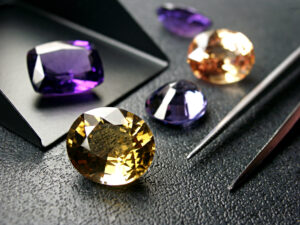 What is Tourmaline Jewelry?
What is Tourmaline Jewelry?
Tourmaline contains boron in the silicate form and mineralogists use this name to refer to vast collection of minerals. Although these minerals share a common crystal structure and similar physical qualities, their chemical compositions differ greatly. Tourmaline jewelry can display a range of colors due to the diverse compositions. It color zoning within the crystals, making it the most versatile group of minerals in terms of color schemes. Tourmaline registers between 7 and 7.5 on the Mohs scale, making it only slightly more durable than quartz.
What Are the Colors of Tourmaline Jewelry?
Do you want to learn the colors of tourmaline jewelry? You are in the right place! Tourmaline comes in more hues than any other gemstone, so it’s only appropriate to serve as October’s birthstone. When leaves in the Northern hemisphere change color. The ancient Egyptians believed that the tourmaline’s rainbow of hues resulted from its long journey from the Earth’s core.
Tourmaline not only represents the birthstone for October but also serves as the gem for the eighth anniversary of marriage. In the Singhalese language, the words “tura mali” signify “stone with mixed colors.” It holds a significant position as the conventional gemstone for both romantic and platonic relationships. Wearing tourmaline is believed to strengthen the wearer’s bonds with others.
Tourmaline belongs to the same family of minerals and possesses the same crystal structure, but has unique chemical and physical properties that result in different colors. Sodium, calcium, lithium, magnesium, iron, manganese, chromium, fluorine, vanadium, and copper contribute to the various hues of tourmaline, which all contain silicon, aluminum, and boron.
Tourmaline encompasses types such as elbaite, liddicoatite, dravite, uvite, and schorl, with elbaites offering a more extensive range of colors, making them suitable for jewelry. They may be colorless or display striped or zoning patterns of varying hues, and their colors can change dramatically with slight alterations in composition.
Tourmaline occurs naturally in every color of the rainbow, with black being the most common color. Other hues include blue, green, yellow, pink, red, orange, purple, brown, and colorless. Many single crystals have distinct bands of color.
The most widely recognized example of a bicolor tourmaline, watermelon tourmaline, is a pink and green variety. It resembles a slice of watermelon, with a pink interior and a green exterior. Indicolite, a blue-green type, and Rubellite, a red-violet type, are two more examples of bicolor tourmalines.
Where Can You Get Tourmaline?
In over 500 years since tourmaline was first mined, Brazil has remained the world’s primary producer. Green and blue tourmaline were acquired by Portuguese explorers in the 1500s from native tribes and by panning streams for gold. Since the late 1800s, miners in the Minas Gerais region of Brazil have unearthed tourmaline in a rainbow of colors, with many pieces featuring a bicolor pattern.
For the past 200 years, dozens of mines in Maine, and beginning in the late 1800s, in southern California, have generated vast quantities of pink and green tourmaline.
Tourmaline deposits are currently being found in nations as diverse as Pakistan, Afghanistan, the United States, Namibia, Mozambique, Nigeria, Tanzania, and others. These deposits are providing the industry with a dynamic source of gem tourmaline and other mineral specimens.
Visit our Gemstone gallery to see the different sorts of Tourmaline.
Conclusion
Tourmalines form in a wet environment and trap some surrounding fluids as inclusions during the crystallization process. Inclusions are apparent to the naked eye in pink and red tourmalines, but these flaws do not lower the gem’s value if it has good color, which is the primary value determinant. Distinctive varieties of tourmaline jewelry come in different colors!
